Looking at biomarkers to predict post-stroke recovery
27 July 2022

Victor Ezeugwu. Photo supplied.
Victor Ezeugwu started his career in Nigeria, where he obtained an MSc in physical therapy. He earned his PhD in rehabilitation science and went on to a postdoctoral fellowship, both at the University of Alberta. He is now an assistant professor in physical therapy in the Faculty of Rehabilitation Medicine.
To get to know him a little better, we asked Victor about his research and where he hopes to take it in the future.
What’s your area of research, and how did you get into it?
My interest in research grew out of my clinical work; I was a physical therapist for many years back in Nigeria. I worked with people with neurological impairments — primarily stroke — but also Parkinson’s and other neurological conditions.
In 2010, after having worked for about 10 years in a hospital, I moved on to do a thesis-based master’s degree. My work looked at lung function in people with stroke, using spirometers to be able to measure lung function. What we found was that lung function values were lower in people with stroke, compared to age and sex-matched healthy adults. So that got me thinking more about how we can improve quality of life for people post-stroke.
In my research, I connected with Dr. Trish Manns who works with people with stroke and we went on to design the STand Up Frequently From Stroke (STUFFS) intervention on reducing sedentary behaviour post-stroke. A big component of my work involves measurement of movement behaviours using accelerometers. I look at whole-day behaviours — sleep, sedentary time, and physical activity at different intensities. An interesting part of this is that even though the recommendations focus mainly on exercise which occupies only a tiny fraction of the day, the whole-day behaviours are co-dependent and interact to influence our health. For example, light intensity physical activity, like how many times people with stroke get up from their seat to get water from the fridge in a day, is becoming recognized as important in the field.
After my PhD, I went on to do a postdoc with Dr. Valerie Carson in the Faculty of Kinesiology, Sport, and Recreation and Dr. Piush Mandhane in the Faculty of Medicine & Dentistry working with a longitudinal birth cohort – the Canadian Healthy Infant Longitudinal Development (CHILD) cohort study, where I looked at the influence of neighbourhood features and weather on device-based measures of movement behaviours in preschoolers. Additionally, I used machine learning to develop a predictive algorithm to identify pre-school children at risk for behaviour changes associated with sleep-related breathing disorders using urine metabolomics and movement behaviours.
Going forwards, one part of my research will involve working with people with stroke. One of the biggest questions I would like to answer is, how can we triage people after a stroke? How do we know who will respond, versus who will not respond to rehabilitation? I will be looking at biomarkers to predict recovery post-stroke.
Where do you want your research to be in five years?
I am interested in exploring both the neurologic and metabolomic biomarkers that impact recovery poststroke. Specifically, what factors differentiate responders from non-responders after a stroke? I will be collecting brain-imaging data, using accelerometers, and measuring function in this area of research.
I am interested in looking at physical- and social-environment correlates and determinants of movement behaviours in people with mobility limitations such as people with Parkinson’s disease, stroke, or peri-op frail adults.
What is the most rewarding aspect of your work?
Connecting and engaging with people and helping them to optimize their function and overall health.
What part of your research is the most challenging?
The biggest challenge that I see in research is getting people to participate. Recruitment of participants is always trouble for those who go into human research. The other thing is time — how to balance your competing priorities. You have to teach, you have your service and your primary research to do, so just balancing all of those can be sometimes challenging.
What do you think you’d be doing if you weren’t a researcher?
My background has been as a clinician. I worked as a physical therapist for many years and I enjoyed doing that, for sure. Also, as a young child, I wanted to be an electrical engineer. My interest around that was that I liked connecting things and seeing how they work.
What’s your favourite distraction?
I like being with my family. I like nature and going to the mountains, or just to the parks to hang out. We’re lucky to be in Alberta and close to the mountains.